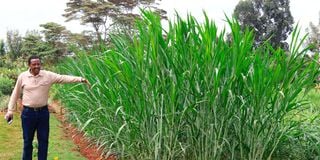Fodder rush should be reason enough to worry farmers

A farmer inspects a plot of Super Napier pakchong grass in Chorong’i village, Nyeri County, on June 21, 2021. The grass originated in Thailand.
There is a flurry of activity in the country occasioned by the shortage of animal feeds, the exorbitant cost of processed feeds and competition between humans and animals for the scarce maize, soy beans and sunflower seeds, among other feed.
The activity shows the industry is responding to a challenge that threatens to suppress livestock, which is a major component of Kenya’s economy.
There have been similar attempts in the past to introduce new feeds on the market but many have fallen flat because the fodder being presented was not well-researched or had been hyped without the claims of superior performance being scientifically verified.
Ordinary Napier grass was a successful fodder introduction into Kenya and was touted to be the panacea of dairy feeds challenge.
Every small to medium dairy venture in the country is incomplete without some clusters of Napier grass.
Despite its great popularity and usage, Napier grass lacks in proteins and energy required by livestock for optimum production.
The protein content, for instance is about five to eight percent against a requirement of 14-22 per cent, depending on the stage of production of cattle and other livestock.
Further, the dry matter content of Napier is low at about 22 percent.
Interestingly, when I ask farmers whether they understand how much Napier grass they would need to give their cattle to meet daily nutritional requirements, a majority are blank.
So the question is what rationale farmers use to feed their cattle with Napier grass.
The answer is that most cattle in zero grazing are permanently in a situation of food and nutritional shortage.
It is the reason they have permanent poor body condition and poor production and reproduction.
It is also one of the reasons the animal breeds are growing smaller by the year because of calf stunting.
I find farmers who ask me where they can get small Friesians or Ayrshires.
My response is that those animals are not small breeds of their types. They are stunted animals that never attained their mature weight and size due to prolonged nutritional stress.
Farmers should know that nutritional stress is one of the factors that can lead to breed size redefinition.
If the animals are bred continuously under nutritional stress, they may eventually change and become small breeds.
Last week, I talked about a fairly new fodder crop being called Super Napier. The plant is a cross of ordinary Napier and pearl millet and was developed in Thailand.
It is a big hype on the Kenyan market, with many people claiming to be multipliers and suppliers.
I have followed some of the proponents of the crop and my findings are interesting.
I have also reviewed the published scientific information on the crop and it looks very promising.
A farmer I visited in Murang’a County two weeks ago said she started planting Super Napier in May and the results have been encouraging.
The Napier lot of about two acres is providing more fodder than the farm needs.
The farm is expanding production to start stockpiling the Napier as silage.
According to Wanjiru, the farm manager, the 70 dairy cattle relish feeding on the Super Napier and have increased milk production highly.
She feeds every animal about six kilogrammes of the Napier daily as part of the total mixed ration of 30 kilos.
The cows are in top condition and show all the signs of feed satisfaction in quantity and nutrient content.
They have very smooth and bright coat colours of the standard black and white Friesians.
Additionally, a majority of the animals lie down calmly and chew the curd after a feeding session.
Wanjiru showed me the areas of the farm she has uprooted her ordinary Napier – Kakamega 1 and 2 varieties and lucern – and planted Super Napier.
It is almost as nutritious as lucern but is much easier to establish and maintain. The Super Napier produces large amounts of forage annually.
Published literature and some local analysis indicate Super Napier contains 16-18 per cent crude protein per kilogramme on dry matter basis compared to 18-22 per cent for lucern.
It also has nine Mega Joules of energy compared to negligible for lucern. This makes it a very suitable cattle feed.
Super Napier is planted as cuttings and is ready for the first harvest in 45 to 70 days.
Subsequent harvests are within 35 to 60 days. Wanjiru was able to confirm the claims on establishing and harvesting Super Napier.
In addition, the crop can produce 200 tonnes of herbage per acre every year, enough to feed 15 to 20 dairy cows.
Due to the hype given to Super Napier by its promoters and proponents, Kenyan con artists have picked up the flurry and livestock farmers are not safe.
Several have called me to narrate how they have been conned with Super Napier.
Other crops creating hype are Juncao grass from China and sugar graze sorghum.
I am yet to understand these two but will revisit their case in the future.
The flurry of activity caused by introduction of the fodder crops calls for the Kenya Directorate of Livestock Production of the State Department of Livestock in the Ministry of Agriculture, Livestock and Fisheries to investigate the veracity of the claims and certify distributors of the fodder crops in order to save farmers from fraudulent suppliers.





